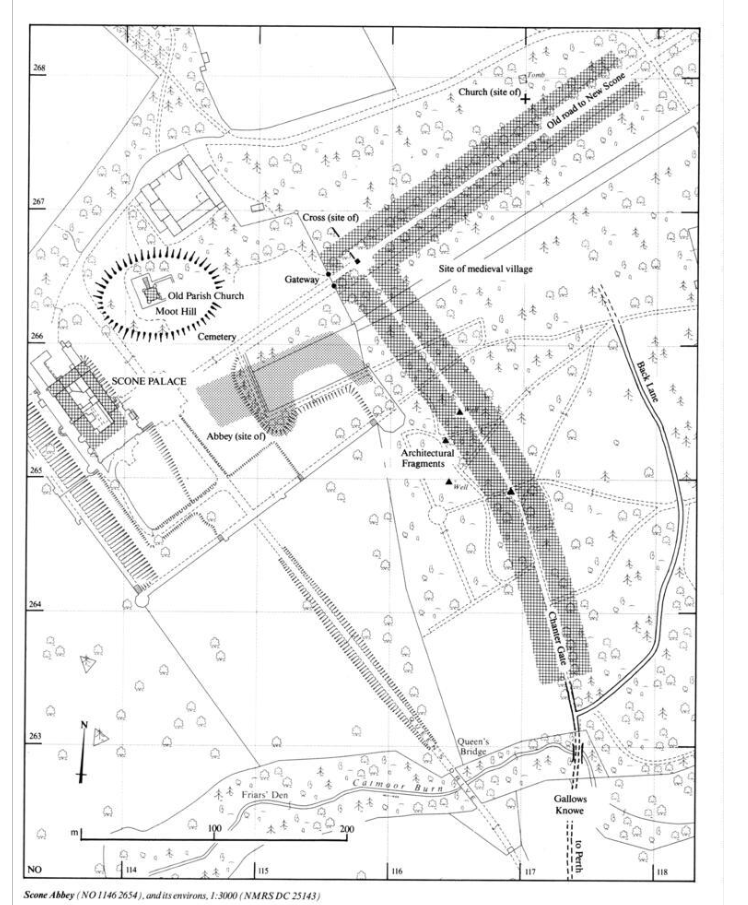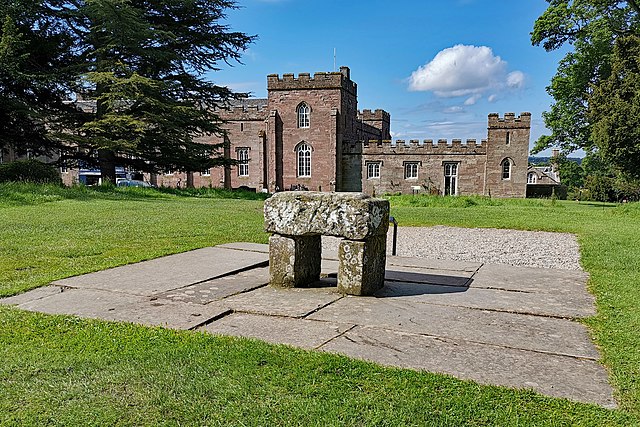Perth and Kinross has some of Scotland’s most important medieval assembly sites. Scone was the traditional place where Scottish kings were inaugurated, and there is evidence for royal assemblies here as early as the 10th century (Anderson 1973, 251; see also early medieval chapter of PKARF). The low oval mound known as the Moothill (MPK3308) has long been recognised as a focal point for medieval ceremonial gatherings. Geophysical survey and limited excavation work in the 2000s significantly enhanced our understanding of this feature. Radiocarbon dates from the ditch around the Moothill suggests that the mound was constructed, or at least raised in height, in the 10th or 11th century (O’Grady 2018, 142–3). Meanwhile, a series of hexagonal stake-holes indicated that a fence was constructed around the Moothill in the 14th or 15th century – arguably a sign of increasing efforts to control access to the mound (O’Grady 2018, 143). The interventions at Scone also identified the foundations of the abbey church which stood to the south of the mound and may have helped to define the outdoor gathering place. Further archaeological investigation at Scone should be a priority, if a suitable opportunity arises.

During the 13th and 14th centuries Scone was a frequent meeting place for the Scottish Parliament (MacDonald 2011, 30). However, from the late 14th century onwards it was increasingly replaced by Perth as a parliamentary venue. Indeed, during the early 15th century Perth was the commonest location for the Scottish Parliament. The parliaments in Perth often met at the burgh’s Dominican friary (MacDonald 2011, 30). Although research has already been undertaken regarding the Dominican site, further exploration of its governmental and ceremonial uses, and of the way in which parliamentary gatherings affected the wider burgh of Perth, would be of considerable interest.

There is also evidence of a significant number of local courts and assembly places in Perth and Kinross. In particular, there are a number of mounds which appear to have formed the focal point for the administration of justice. Many of these mounds probably had early medieval or prehistoric origins. Yet in some places they continued in use into the 17th century. For example, the mound at Stayt of Crieff (MPK838) was supposedly the site of the court of the Earls of Strathearn and their stewards as late as 1665. While some research has been undertaken regarding the sites of outdoor courts, further interdisciplinary research involving field work, place-name evidence, and written sources would be desirable (O’Grady 2008 [SET1]). By the 15th and 16th centuries courts and public gatherings were increasingly moving to indoor venues. Further research into the buildings used would be helpful. It is likely that written sources will play a key role in identifying the locations of late medieval courts.
Purpose built civic spaces became more common in Scotland towards the end of the Middle Ages, leading to the construction of tolbooths or town halls. Research into the history of Perth’s tolbooth should be a priority. There is written evidence for a tolbooth at Perth in the 15th century, but little is known about its medieval appearance (Records of the Parliaments of Scotland 1445/1). The medieval tolbooth at Perth may have been demolished in the late 17th century when the burgh council ordered the construction of a new ‘Council House, Clerks’ Chamber, and Pack House’ (Fittis 1885, 272–3).
| HER / Canmore ID | Place (Site and Locality) | National Grid Reference | State of Remains / Description | Archaeological Investigations |
| MPK490/ 25030 | Tom a’ Mhoid, Fearnan | NN 7222 4449 | Wooded knoll with a tradition of courts and gallows. | None |
| MPK838/ 25434 | Stayt of Crieff (also known as Court Hill), Crieff | NN 8669 2066 | A Bronze Age burial mound, removed in 19th century, said to have been where the Earls of Strathearn and their stewards held court until 1665. Site documented in 1358. | Antiquarian investigation in 1860 when mound was levelled. |
| MPK2435/ 27140 | Mute Hill (also known as Caputh Church), Caputh | NO 0822 4008 | Hill said to have been where ‘justice was administered in former times’. The old parish church at Caputh was located on this hill. | Field visit by RCAHMS in 1989. |
| MPK3074/ 27922 | Preaching How (also known as Castle Law), Abernethy | NO 1839 1548 | Flat natural shelf. May possibly be the Preaching How described in the 1860 OS Namebook. | Field visit by RCAHMS in 1996. |
| MPK5119/ 32008 | Market Knowe, Longforgan | NO 3122 3058 | Probably the site of the barony court of Longforgan in the 14th century. It is also claimed that Longforgan market took place here until 1633. | Topographic and geophysical surveys (EPK1221 and 1298). |
| MPK5474/ 28191 | Moothill (also known as Boothill and Scone Palace Policies), Scone | NO 1140 2663 | A flat-topped artificial mound which was a royal assembly and inauguration site. | Geophysical surveys and trial trenching (EPK635 and 801). |
| MPK328/ 24854 | Court Knoll, Dalginross | NN 77712105 | Former mound, opened in early 19th century when a cist and cremation discovered. Named ‘Court Knoll’ on a plan of 1802. Levelled around1940. It may be the same site as MPK331 Dunmoid. | Antiquarian investigation in early 1800s. |
| MPK331/ 24857 | Dunmoid (also known as Roundel and Muirend), Dalginross | NN 7802 2126 | Prehistoric stone circle. Name Dunmoid translates to ‘hill of judgement’ or ‘hill or mound of assembly’. | Emergency Survey by RCAHMS in 1942. |
| MPK177/ 24498 | Baron Court, Kiltyrie | NN 6300 3662 | Remains of a possible barrow. Traditionally said to be the site of a baron court. | Field visit by RCAHMS 2005. |
| MPK2327/ 27025 | Loak Court Hill, Bankfoot | NO 0773 3300 | Turf covered barrow named ‘Court Hill’. Traditionally the site of judicial courts prior to 1745. | Emergency Survey by RCAHMS in 1942. |
| MPK3954/ 28970 | Castlehill, Clunie | NO 3111 7440 | A natural knoll upon which a motte, and later a castle, was built. The mound was a place of royal assembly and the administration of justice by the 12th century (M Hall 2015a). | Field visits and survey by RCAHMS 1979 & 1989. Geophysical survey and limited excavations by University of Aberdeen 2018–9 |
